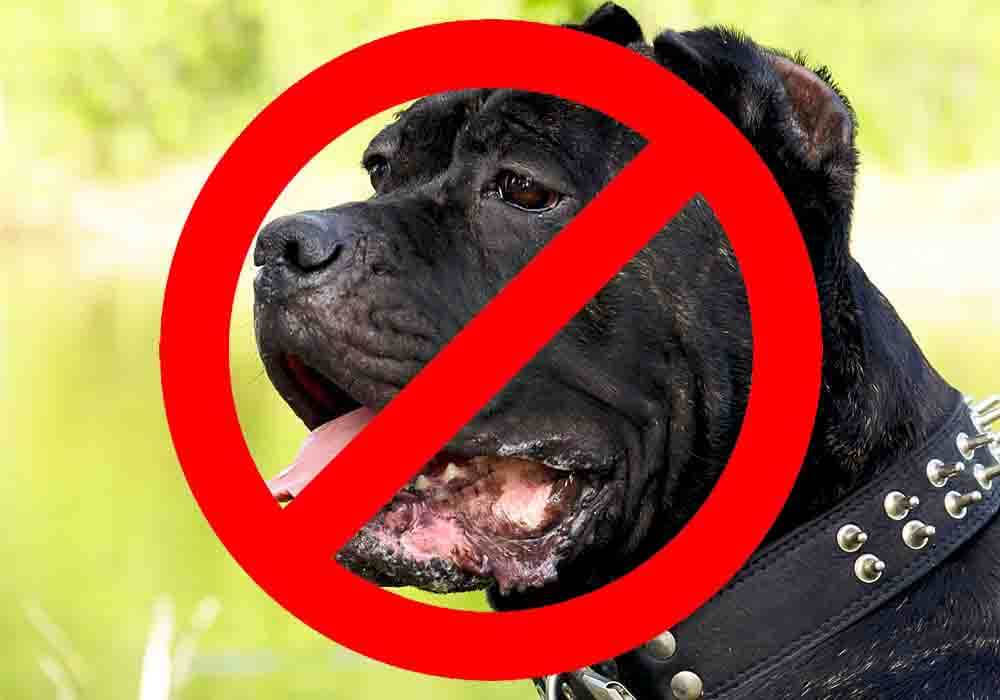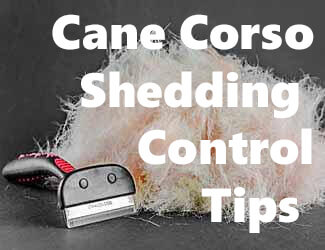Where Are Cane Corsos Legal Or Banned?
Helpful Information To Know Before Traveling Or Moving
by Ken Alden
So where are Cane Corsos Legal Or Banned? Many places around the world have some form of breed-specific location which bans specific breeds. The Cane Corso is a breed of dog commonly found on these lists.
Where Are Cane Corsos Legal Or Banned?
- Legal: US, Australia, and Singapore though they may require you to take certain precautions
- Banned: Canada, Germany, England (in some municipalities), Ireland, and France.
This article will tackle where a Cane Corsos are banned or legal, and the rules regarding owning one in these areas. Keep reading below if you want to know more specific details....
Pro-tip: Ever try lifting a Cane Corso? Their weight can hurt not only your back but their joints when they hop down from cars, sofas or even your bed. To protect your back and theirs check out the best Mastiff ramps on Amazon.com now.

Why Are Cane Corso Banned in Certain Countries?
A Cane Corso is a large breed dog with an intimidating muscular stance and a fierce protective streak. Their breed cannot live in all areas due to being a type of Mastiff with many similarities to Pitbulls.
Many places have breed-specific legislation (BSL) that regulates the types of dogs you can have. These rules apply to breeds that have been declared dangerous or aggressive. where are cane corsos legal or banned
Unfortunately, based on these rules, a breed can land on the list due to the resemblance to other banned breeds like a Pitbull or Mastiff.
Breeds that commonly face prejudice due to BSL include:
- Bullmastiff
- Pitbull
- American Staffordshire Terrier
- Doberman Pinscher
- Cane Corso
- German Shepherd
- Rottweiler
- American Bulldog
- Staffordshire Bull Terrier
- Wolf Hybrids
- Chow Chow
Breed discriminatory legislation varies by country and in the rules for having a dog of that breed. Restrictions you can face regarding a dog on a BSL include having to have your pet muzzled when in public, microchipped, neutered or spayed, kept up to date on rabies, and use signs warning of your pet’s presence.
Here's a helpful article we wrote on this website that delves deeper into just how aggressive or dangerous the Cane Corso can get. This article may surprise you.
Are Cane Corso Legal or Banned in Australia?
Australia has open arms when it comes to adopting a Cane Corso. This breed of dog hasn’t been in Australia long. The Australian National Kennel Council (ANKC) didn’t officially recognize the breed until 2003, although the Cane Corso's lineage goes back to ancient times.
There are currently only around 20 Cane Corsos in Australia's entire continent with registered papers and a pure pedigree. This low number is not due to being banned, but because they are becoming popular outside of Italy, where they originated.
Are Cane Corso Legal or Banned in Canada?
Many Canadian areas have strict breed-specific legislation that prohibits the possession of dogs they perceive as potentially dangerous.
These legislations vary depending on location. Many humane societies in Canada are fighting to have the BSL abolished or changed, as the laws do not help reduce dog bites. where are cane corsos legal or banned
According to the Toronto Humane Society, in one study of 36 Canadian municipalities, there was zero difference between BSL areas and those that don't.
But breed discriminatory legislation does cause many innocent pets to be euthanized simply for being a particular breed. It also causes problems with pet owners who have never had issues with their dogs.
Calgary
Calgary does not use breed-specific legislation to ban dogs based on breeds. Cane Corso, as well as many other dangerous breeds, are welcome.
Over twenty years since 1986, when there were ten bites per 10,000 people, dog attacks dropped to two incidents in 2006. The success of this is not due to getting rid of certain breeds. Calgary has strong licensing requirements, so inexperienced owners don’t end up with dangerous dogs they can’t control.
They also offer dog safety public education programs to inform the public and dog owners on proper pet care.
Pro-tip: Cane Corso anxiety, aggression, destructive chewing, jumping up, fearfulness, and other behaviors can be controlled with the right training program.
Here’s a great course that
addresses these issues along with many other dog training basics: Check it out now!
Are Cane Corso Legal or Banned in England?
The Parliament of the United Kingdom passed the Dangerous Dogs Act in 1991, which prohibits the ownership, breeding, giving away, or selling of fighting dogs. Dogs that fall under the category of dogs bred for fighting include Pitbull Terriers, Japanese Tosa, Dogo Argentino (a large Mastiff), and Fila Brasileiro.
Your dog can fall under the ban in the UK, even if they are not one of these breeds, but have resemblances. Since the Cane Corso is a Mastiff, the species is banned in some areas. Some municipalities* allow you to have your Cane Corso labeled as exempted, meaning you can continue to keep your pet without penalty, but you have to meet strict guidelines:
- Prove that your pet is not dangerous.
- Have a Dog Legislation Officer (DLO) examine your dog.
- Prove that you are a responsible adult capable of caring for your pet.
- Get your pet spayed or neutered.
- Microchip your dog.
- Have third-party liability insurance to cover any dog attacks.
- Keep your address up to date where the pet resides.
- Muzzle your pet in public.
- Keep on a short leash and be contained safely at home.
* If in doubt, contact your municipality since the laws can and do vary and can change quickly too. We at Mastiff Guide wonder how they'd respond if told your dogs a mix. lol
Are Cane Corso Legal or Banned in France?
In 1999, France created restrictions on dogs labeled dangerous. There are currently two types your dog could fall into depending on their breed. Since Cane Corso is a type of Mastiff, he may fall under one of these categories. Regardless of your pet's lineage, if you do not have pedigree paperwork for them, they are considered a Category 1.
Category 1: Attack Dogs
Category 1 is called attack dogs and includes cross-breeds or relatives of Boerbull Mastiff, American Staffordshire Terrier, or Japanese Tosa.
Dogs fall under Category 1 if you do not have paperwork marking their lineage. Your pet should be registered in the LOF or Livre des Origines Français, a record of all breeds.
Dogs that fall under a Category 1 can be seized and euthanized by authorities in an attempt to abolish non-pedigree Pitbull and Mastiff mixes.
Category 1 dogs cannot be bought, sold, given away, or imported. You also require a permit to keep a Category 1 and 2 dogs. Category 1 dogs cannot go into any public place other than a sidewalk or stay in shared accommodation.
Category 2: Guard Dogs
Category 2 is considered a guard dog or defense dog category. These are dogs with Pedigree papers listing them as American Staffordshire Terriers, Tosa, Rottweilers, or any crossbreeds related to these breeds.
To own a dog labeled Category 1 or 2, you must meet the following criteria:
- Be over 18.
- No criminal record.
- Declare your dog at the Mairie.
- Keep your pet up to date on rabies vaccinations.
- Have a behavioral evaluation completed on your pet.
- Retain specialist civil liability insurance.
- Keep your pet on a leash in public and muzzled.
- Category 1 dogs must be sterilized.
- The dog must be microchipped.
- Take a mandatory seven-hour training course.
Are Cane Corso Legal or Banned in Germany?
As of 2001, Germany has restrictions on banning the import or transfer of dogs deemed dangerous. This Dog Transfer and Import Restrictions Act prevents bringing in or crossbreeding the following:
- Pitbull Terrier
- American Staffordshire Terrier
- Staffordshire Bull Terrier
- Bull Terrier
If you plan to stay in Germany for no more than four weeks, these regulations will not apply. It also does not apply to dogs who have previously lived in Germany. Paperwork must be shown to establish your dog’s breed.
In specific Federal Lands in Germany, you may have to get permission from the local authorities to have a Cane Corso, as they are labeled dangerous in these locations.
Areas where Cane Corso is a dangerous breed include:
- Bavaria
- Berlin
- Brandenburg
- North Rhine-Westphalia
In Bavaria, Cane Corso is a Category 2, which is considered dangerous. To have a Category 2, your dog must pass a temperament test and register with the safety and public order office. If your pet fails the test, they are labeled a Category 1, which is illegal.
Are Cane Corso Legal or Banned in Ireland?
The Control of Dogs Regulations of 1998, as proposed by the Minister for the Environment and Local Government, sets strict guidelines for the ownership of dogs labeled dangerous. where are cane corsos legal or banned
As is typical in many areas, the list for restricted breeds in Ireland include:
- American Pit Bull Terrier
- Staffordshire Bull Terrier
- Doberman Pinscher
- German Shepherd
- Japanese Akita
- Rhodesian Ridgeback
- Japanese Tosa
- Rottweiler
- English Bull Terrier
- Bull Mastiff
- Ban dogs (a cross between any of the above breeds or any strain of listed breeds)
All dogs, regardless of breed, require a license and must have a microchip. Your dog also has to wear a collar with the owner’s name and address. Walking a dangerous dog requires a person over the age of 16, using a leash less than 6 feet (2 meters) with your dog muzzled.
Are Cane Corso Legal or Banned in NZ?
New Zealand does not have a ban on Cane Corso. There are many high-quality breeders so you can find the prime stock.
The New Zealand Kennel Club recognizes Cane Corso as a breed and provides the same breed standards as other kennel clubs.
Be sure you keep up with your pet’s Pedigree papers, so you don’t run into problems with an uneducated person assuming your Corso is an American Pit Bull Terrier, which is banned in New Zealand.
Pro-tip: Cane Corso's (and their owners) love dog crates…and for good
reasons. Crates keep dogs from mischief while you're away, are perfect for house
training, for traveling by car, and provide the dog a place to de-stress. Check
out the best Mastiff crates on Amazon.com now.
Are Cane Corso Legal or Banned in Ontario?
The province of Ontario introduced breed-specific legislation in 2005 under their Public Safety Related to Dog Statute Law Amendment Act. They also amended the Dog Owners Liability Act (DOLA).
As of August 29, 2005, all Pitbulls are banned from Ontario, including importation or breeding. It also outlined strict restrictions on existing Pitbulls in the area and the penalties for dangerous breeds owners.
Under these regulations, any dog falls under a Pitbull category if they are:
- Pitbull Terriers
- Staffordshire Bull Terriers
- American Staffordshire Terriers
- American Pitbull Terriers
- Any dog that shares similar appearance or physical characteristics, such as a Cane Corso
Rules for Banned Pets in Ontario
If you own a dangerous pet, you have to follow specific guidelines not to face penalties. Your pet must be muzzled and leashed at all times in public. On private property, you must have a way to keep them restricted to your area through a tall fence or kennel.
Are Cane Corso Legal or Banned in Singapore?
Cane Corso is not banned in Singapore, but they have to follow specific rules due to the stigma on large breed dogs that look aggressive. This breed falls under Part 2 in the Second Schedule of the Animals and Birds (Dog Licensing and Control) Rules, which means there are guidelines to ownership.
Any dog you have in Singapore must have a valid license, and there is a limit of one dog of an approved breed or its cross. You have to keep your pet on a leash at all times in a public area, and they must wear a muzzle.
Microchipping is required, and you must hold a $100,000 insurance personal injury insurance policy. You must also pay a $2,000 banker’s guarantee. Finally, all dogs must undergo obedience training.
Are Cane Corso Legal or Illegal in the United States?
In the United States, multiple states enforce breed-specific legislation preventing the ownership of aggressive breeds. There are currently over 700 cities in the country with some BSL.
Breeds that are commonly targeted include:
- Pitbull
- Bullmastiff
- American Staffordshire Terrier
- Belgian Malinois
- Dogo Argentino
- Doberman Pinscher
- Cane Corso
- German Shepherd
- Rottweiler
- Alaskan Malamute
- Siberian Husky
- Bull Terrier
- Presa Canario
- Wolf hybrids
- Staffordshire Bull Terrier
- American Bulldog
Breed-specific legislation has been a thing in America since the 1980s. However, there is much debate on whether the regulations work.
Many organizations protest BSL's use, as it is often prejudiced against a dog based on breed or looks and not on temperament and behavior.
States that currently have bans against Cane Corsos include:
- Arkansas
- Kansas
- Iowa
- Nebraska
- New Mexico
- Louisiana
- Missouri
- Montana
- Idaho
- Wyoming
- North Dakota
- Oregon
- Washington
- Kentucky
- Ohio
- Tennessee
- West Virginia
- Wisconsin
- Michigan
- Indiana
- Georgia
- Mississippi
- South Carolina
- North Carolina
- Alabama
- Maryland
- Vermont
- Delaware
California, Florida, Illinois, and Colorado have state laws prohibiting breed-specific legislation. The rules regarding how banned breeds are handled vary by location.
Some areas may not allow the breed at all, while others have a ban against bringing your Cane Corso into public places. You may also have to do the following:
- Put a muzzle on your pet in public.
- Sterilize them.
- Keep your pet in a specific type of kennel.
- Keep your pet leashed.
- Hold liability insurance.
- Display vicious dog signs at your residence.
- Tag your dog with a vicious warning sign.
Cane Corso Banned In Which Other Countries?
Cane Corsos are also banned in the Bermuda Islands, along with 19 other dogs, including breeds with similar physical characteristics.
In the Ukraine, the Cane Corso is on the list of restricted dogs labeled as dangerous breeds, which has been expanding since 1998 and currently includes over 80 types.
In this country, you must retain civil liability insurance by keeping your dog on a short leash while wearing a muzzle and having your pet microchipped.
For a more comprehensive listing of legal and banned breeds across the globe please visit this helpful site
Where Are Cane Corsos Legal Or Banned?...Final Thoughts
Cane Corsos are often banned in many areas for fear that it is a dangerous dog. Before you decide to adopt a Cane Corso, check with your area to determine the rules regarding this breed. You may have to adhere to certain rules to avoid penalization and losing your pet.
Return to the top of this Where Are Cane Corsos Legal Or Banned? page

About the Author...
Ken Alden, a dedicated Mastiff owner for over eight years, is acclaimed for his expertise in care, grooming, and training. Read more About Me and my dog Shadow.
- Mastiff Guide Home ›
- Cane Corsos ›
- Where Are Cane Corsos Legal Or Banned?






